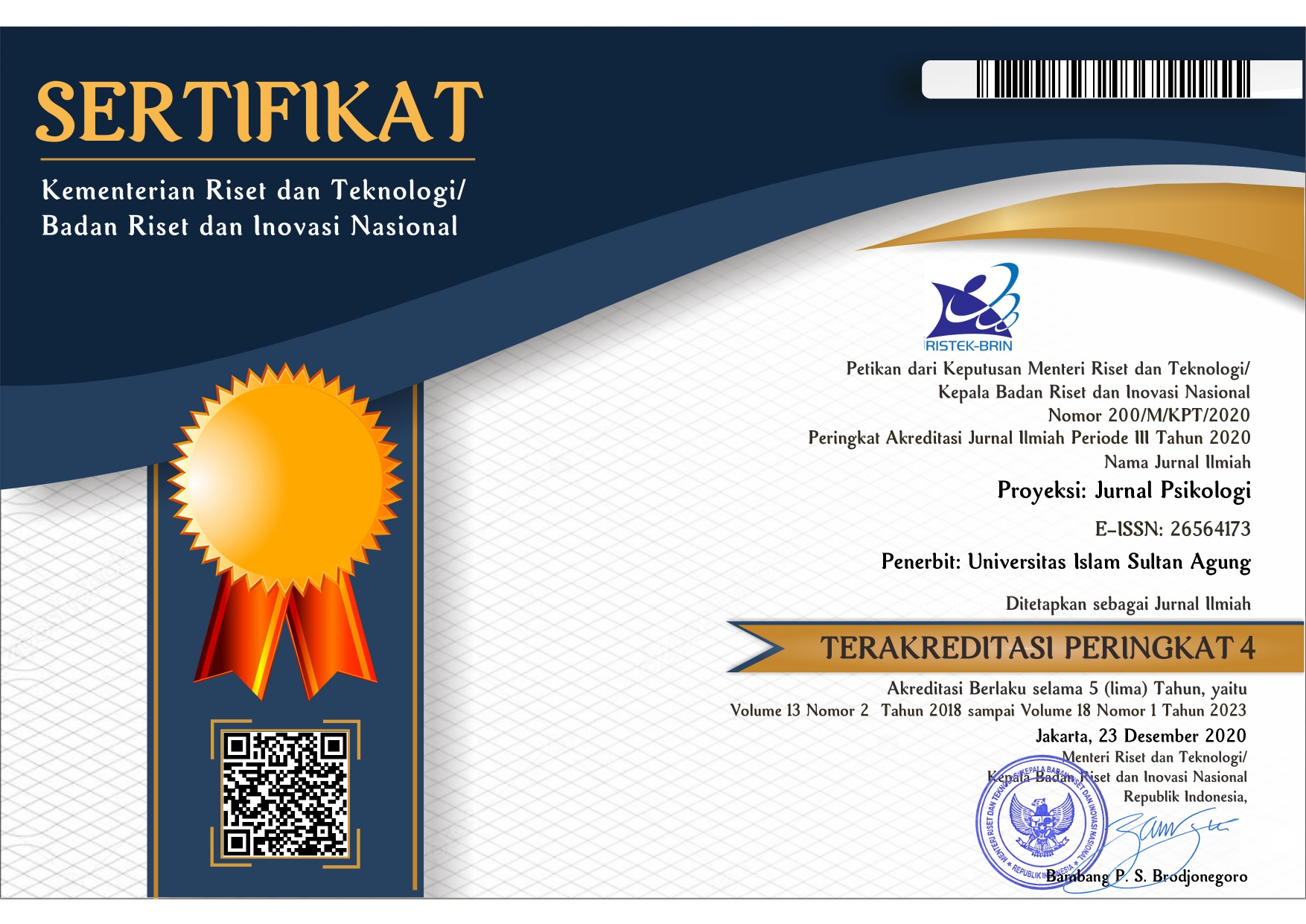PENGEMBANGAN SKALA IDENTITAS SOSIAL : VALIDITAS, DAN ANALISIS FAKTOR EKSPLORATORI
Abstract
Â
Penelitian ini bertujuan untuk mengembangkan alat ukur dan melakukan validasi terhadap skala identitas sosial. Skala identitas sosial diuji kepada mahasiswa angakatan 2018, laki-laki dan perempuan, serta berusia 16-21 tahun dengan total subjek sebanyak 226 mahasiswa. Pengembangan skala identitas sosial berdasarkan teori Cameron (2004) yang terbagi menjadi 3 aspek utama. Hasil penelitian dengan melakukan uji analisis faktor eksploratori menunjukkan bahwa identitas sosial memiliki nilai KMO sebesar 0.808. Selain itu identitas sosial terbagi menjadi 4 faktor yang telah dinamanakan menjadi faktor reflective, belonging, unsatisfaction, dan unconscious.
Â
Keywords
Full Text:
PDFReferences
Anastasi, A & Urbina, S. (1997). Psychological testing. (7th Ed). Indiana: PrenticeHall, Inc
Azwar, S. (2007). Reliabilitas dan Validitas. Yogyakarta: Pustaka Belajar
Bitz, K. (2013). Measuring Advisor Relationship Perceptions Among First-Year Students at a Small Midwestern University. NACADA Journal, 30(2), 53–64. https://doi.org/10.12930/0271-9517-30.2.53
Cameron, J. E. (2004). A Three-Factor Model of Social Identity. Self and Identity, 3(3), 239–262. https://doi.org/10.1080/13576500444000047
Christian, J., Bagozzi, R., Abrams, D., and Rosenthal, H. 2012. Social influence in newly formed groups: The roles of personal and social intentions, group norms, and social identity. Personality and Individual Differences, 52 (3), 255-260
Cruwys, T., Haslam, S. A., Dingle, G. A., Haslam, C., & Jetten, J. (2014). Depression and Social Identity: An Integrative Review. Personality and Social Psychology Review, 18(3), 215–238. https://doi.org/10.1177/1088868314523839
Ghozali, I., Model Persamaan Struktural Konsep dan Aplikasi dengan Program Amos 16. Semarang: Badan Penerbit – Undip (2005)
Haslam, C., Holme, A., Haslam, S. A., Iyer, A., Jetten, J., & Williams, W. H. (2008). Maintaining group memberships: Social identity continuity predicts well-being after stroke. Neuropsychological Rehabilitation, 18(5–6), 671–691. https://doi.org/10.1080/09602010701643449
Haslam, S. A., Jetten, J., Postmes, T., & Haslam, C. (2009). Social identity, health and well-being: An emerging agenda for applied psychology. Applied Psychology, 58(1), 1–23. https://doi.org/10.1111/j.1464-0597.2008.00379.x
Hogg, M. A., and Tindale, R. S. 2003. Social Identity, Influence, and Communications in Small Groups. in J. Harwood & H. Giles (ed). Intergroup Communication: Multiple Perspective, Pp. 141-164. New York: Peter Lang
Isaksson, A., Martin, P., Kaufmehl, J., Heinrichs, M., Domes, G., & Rüsch, N. (2017). Social identity shapes stress appraisals in people with a history of depression. Psychiatry Research, 254(April 2016), 12–17. https://doi.org/10.1016/j.psychres.2017.04.021
Palmer, A., Koenig-Lewis, N., and Jones, L. E. M. 2013. The effects of residents' social identity and involvement on their advocacy of incoming tourism. Tourism Management, 38, 142-151
Petta, G., & Walker, I. (1992). Relative deprivation and ethnic identity. British Journal of Social Psychology, 31(4), 285-293. doi: 10.1111/j.20448309.1992.tb00973.x
Postmes, T., Haslam, S. A., & Jans, L. (2013). A single-item measure of social identification: Reliability, validity, and utility. British Journal of Social Psychology, 52(4), 597–617. https://doi.org/10.1111/bjso.12006
Praharso, N. F., Tear, M. J., & Cruwys, T. (2017). Stressful life transitions and wellbeing: A comparison of the stress buffering hypothesis and the social identity model of identity change. Psychiatry Research, 247(June 2016), 265–275. https://doi.org/10.1016/j.psychres.2016.11.039
Suharnan, *. (2014). Pengembangan Skala Kemandirian. Persona:Jurnal Psikologi Indonesia, 1(2). https://doi.org/10.30996/persona.v1i2.26
Tajfel, H. (1974). Social identity and intergroup behaviour. Social Science Information, 13(2), 65–93. https://doi.org/10.1177/053901847401300204
Tajfel, H. (1981) Human groups and social categories: studies in social psychology. Cambridge, UK: Cambridge University Press.
Taylor, S.E., Peplau, L.A., dan Sears, D.O. 2009. Psikologi Sosial. Edisi Keduabelas. Alih Bahasa: Tri Wibowo, B.S. Jakarta: Kencana Prenada Media Group.
Thompson, B. (2004). Exploratory and Confirmatory Factor Analysis: Understanding Concepts and Applications. Washington DC: American Psychological Association.
Tougas, F., & Beaton, A.M. (2002). Personal and group deprivation relative: Connecting the “I†to the “Weâ€. Dalam I. Walker dan H.J
Smith (Ed), Deprivasi relatif: specification, development and integration (119-135). Cambridge: Cambridge University Press.
Zaglia, M. E. 2013. Brand communities embedded in social networks. Journal of Business Research, 66(2), 216-2
DOI: http://dx.doi.org/10.30659/jp.15.1.58-67
Refbacks
- There are currently no refbacks.

Proyeksi by http://jurnal.unissula.ac.id/index.php/proyeksi/ is licensed under a Creative Commons Attribution-ShareAlike 4.0 International License.

